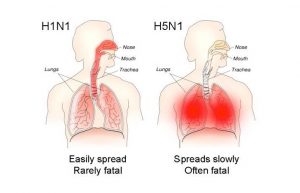H5N1 Avian Influenza:

On July 21, an 11-year-old boy died of H5N1 avian influenza in Delhi. This is the first recorded death due to the bird flu in India this year. In January, bird flu was confirmed in several states with thousands of birds, including migratory species, being found dead.
- Bird flu or avian influenza is a disease caused by avian influenza Type A viruses found naturally in wild birds worldwide.
- The virus can infect domestic poultry including chickens, ducks, turkeys and there have been reports of H5N1 infection among pigs, cats, and even tigers in Thailand zoos.
- Avian Influenza type A viruses are classified based on two proteins on their surfaces – Hemagglutinin(HA) and Neuraminidase(NA). There are about 18 HA subtypes and 11 NA subtypes. Several combinations of these two proteins are possible e.g., H5N1, H7N2, H9N6, H17N10, etc.
- There have been reports of avian and swine influenza infections in humans including A(H1N1), A(H1N2), A(H5N1), A(H7N9), etc. The first report of human H5N1 infection was in 1997.
- The most common route of virus transmission is direct contact — when a person comes in close contact with infected birds, either dead or alive




